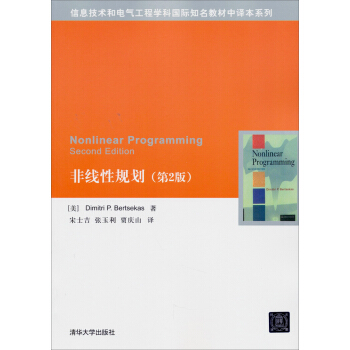

齣版社: 世界圖書齣版公司
ISBN:9787506271813
版次:1
商品編碼:10175537
包裝:平裝
開本:24開
齣版時間:2004-11-01
用紙:膠版紙
頁數:617
具體描述
內容簡介
The relationships (both conceptual and mathematical) between Bayesian analysis and statistical decision theory are so strong that it is somewhat unnatural to learn one without the other. Nevertheless, major portions of each have developed separately. On the Bayesian side, there is an extensively developed Bayesian theory of statistical inference (both subjective and objective versions). This theory recognizes the importance of viewing statistical analysis conditionally (i.e., treating observed data as known rather than unknown), even when no loss function is to be incorporated into the analysis. There is also a well-developed (frequentist) decision theory, which avoids formal utilization of prior distributions and seeks to provide a foundation for frequentist statistical theory. Although the central thread of the book will be Bayesian decision theory, both Bayesian inference and non-Bayesian decision theory will be extensively discussed. Indeed, the book is written so as to allow, say, the teaching of a course on either subject separately.目錄
CHAPTER 1Basic Concepts
1.1 Introduction
1.2 Basic Elements
1.3 Expected Loss, Decision Rules, and Risk
1.3.1 Bayesian Expected Loss
1.3.2 Frequentist Risk
1.4 Randomized Decision Rules
1.5 Decision Principles
1.5.1 The Conditional Bayes Decision Principle
1.5.2 Frequentist Decision Principles
1.6 Foundations
1.6.1 Misuse of Classical Inference Procedures
1.6.2 The Frequentist Perspective
1.6.3 The Conditional Perspective
1.6.4 The Likelihood Principle
1.6.5 Choosing a Paradigm or Decision Principle
1.7 Sufficient Statistics
1.8 Convexity
Exercises
CHAPTER 2 Utility and Loss
2.1 Introduction
2.2 Utility Theory
2.3 The Utility of Money
2.4 The Loss Function
2.4.1 Development from Utility Theory
2.4.2 Certain Standard Loss Functions
2.4.3 For Inference Problems
2.4.4 For Predictive Problems
2.4.5 Vector Valued Loss Functions
2.5 Criticisms
Exercises
CHAPTER 3 Prior Information and Subjective Probability
3.1 Subjective Probability
3.2 Subjective Determination of the Prior Density
3.3 Noninformative Priors
3.3.1 Introduction
3.3.2 Noninformative Priors for Location and Scale Problems
3.3.3 Noninformative Priors in General Settings
3.3.4 Discussion
3.4 Maximum Entropy Priors
3.5 Using the Marginal Distribution to Determine the Prior
3.5.1 The Marginal Distribution
3.5.2 Information About tn
3.5.3 Restricted Classes of Priors
3.5.4 The ML-II Approach to Prior Selection
3.5.5 The Moment Approach to Prior Selection
3.5.6 The Distance Approach to Prior Selection
3.5.7 Marginal Exchangeability
3.6 Hierarchical Priors
3.7 Criticisms
3.8 The Statisticians Role
Exercises
CHAPTER 4 Bayesian Analysis
4.1 Introduction
4.2 The Posterior Distribution
4.2.1 Definition and Determination
4.2.2 Conjugate Families
4.2.3 Improper Priors
4.3 Bayesian Inference
4.3.1 Estimation
4.3.2 Credible Sets
4.3.3 Hypothesis Testing
4.3.4 Predictive Inference
4.4 Bayesian Decision Theory
4.4.1 Posterior Decision Analysis
4.4.2 Estimation
4.4.3 Finite Action Problems and Hypothesis Testing
4.4.4 With Inference Losses
4.5 Empirical Bayes Analysis
4.5.1 Introduction
4.5.2 PEB For Normal Means--The Exchangeable Case
4.5.3 PEB For Normal Means--The General Case
4.5.4 Nonparametric Empirical Bayes Analysis
4.6 Hierarchical Bayes Analysis
4.6.1 Introduction
4.6.2 For Normal Means--The Exchangeable Case
4.6.3 For Normal Means--The General Case
4.6.4 Comparison with Empirical Bayes Analysis
4.7 Bayesian Robustness
4.7.1 Introduction
4.7.2 The Role of the Marginal Distribution
4.7.3 Posterior Robustness: Basic Concepts
4.7.4 Posterior Robustness: s-Contamination Class
4.7.5 Bayes Risk Robustness and Use of Frequentist Measures
4.7.6 Gamma-Minimax Approach
4.7.7 Uses of the Risk Function
4.7.8 Some Robust and Nonrobust Situations
4.7.9 Robust Priors
4.7.10 Robust Priors for Normal Means
4.7.11 Other Issues in Robustness
4.8 Admissibility of Bayes Rules and Long Run Evaluations
4.8.1 Admissibility of Bayes Rules
4.8.2 Admissibility of Generalized Bayes Rules
4.8.3 Inadmissibility and Long Run Evaluations
4.9 Bayesian Calculation
4.9.1 Numerical Integration
4.9.2 Monte Carlo Integration
4.9.3 Analytic Approximations
4.10 Bayesian Communication
4.10.1 Introduction
4.10.2 An Illustration: Testing a Point Null Hypothesis
4.11 Combining Evidence and Group Decisions
4.11.1 Combining Probabilistic Evidence
4.11.2 Combining Decision-Theoretic Evidence
4.11.3 Group Decision Making
4.12 Criticisms
4.12.1 Non-Bayesian Criticisms
4.12.2 Foundational Criticisms
Exercises
CHAPTER 5 Minimax Analysis
5.1 Introduction
5.2 Game Theory
5.2.1 Basic Elements
5.2.2 General Techniques for Solving Games
5.2.3 Finite Games
5.2.4 Games with Finite
5.2.5 The Supporting and Separating Hyperplane Theorems
5.2.6 The Minimax Theorem
5.3 Statistical Games
5.3.1 Introduction
5.3.2 General Techniques for Solving Statistical Games
5.3.3 Statistical Games with Finite
5.4 Classes of Minimax Estimators
5.4.1 Introduction
5.4.2 The Unbiased Estimator of Risk
5.4.3 Minimax Estimators of a Normal Mean Vector
5.4.4 Minimax Estimators of Poisson Means
5.5 Evaluation of the Minimax Principle
5.5.1 Admissibility of Minimax Rules
5.5.2 Rationality and the Minimax Principle
5.5.3 Comparison with the Bayesian Approach
5.5.4 The Desire to Act Conservatively
5.5.5 Minimax Regret
5.5.6 Conclusions
Exercises
CHAPTER 6 Invariance
6.1 Introduction
6.2 Formulation
6.2.1 Groups of Transformations
6.2.2 Invariant Decision Problems
6.2.3 Invariant Decision Rules
6.3 Location Parameter Problems
6.4 Other Examples of Invariance
6.5 Maximal lnvariants
6.6 Invariance and Noninformative Priors
6.6.1 Right and Left Invariant Haar Densities
6.6.2 The Best Invariant Rule
6.6.3 Confidence and Credible Sets
6.7 Invariance and Minimaxity
6.8 Admissibility of Invariant Rules
6.9 Conclusions
Exercises
CHAPTER 7 Preposterior and Sequential Analysis
7.1 Introduction
7.2 Optimal Fixed Sample Size
7.3 Sequential Analysis--Notation
7.4 Bayesian Sequential Analysis
7.4.1 Introduction
7.4.2 Notation
7.4.3 The Bayes Decision Rule
7.4.4 Constant Posterior Bayes Risk
7.4.5 The Bayes Truncated Procedure
7.4.6 Look Ahead Procedures
7.4.7 Inner Truncation
7.4.8 Approximating the Bayes Procedure and the Bayes Risk
7.4.9 Theoretical Results
7.4.10 Other Techniques for Finding a Bayes Procedure
7.5 The Sequential Probability Ratio Test
7.5.1 The SPRT as a Bayes Procedure
7.5.2 Approximating the Power Function and the Expected Sample Size
7.5.3 Accuracy of the Wald Approximations
7.5.4 Bayes Risk and Admissibility
7.5.5 Other Uses of the SPRT
7.6 Minimax Sequential Procedures
7.7 The Evidential Relevance of the Stopping Rule
7.7.1 Introduction
7.7.2 The Stopping Rule Principle
7.7.3 Practical Implications
7.7.4 Criticisms of the Stopping Rule Principle
7.7.5 Informative Stopping Rules
7.8 Discussion of Sequential Loss Functions
Exercises
CHAPTER 8 Complete and Essentially Complete Classes
8.1 Preliminaries
8.2 Complete and Essentially Complete Classes from Earlier Chapters
8.2.1 Decision Rules Based on a Sufficient Statistic
8.2.2 Nonrandomized Decision Rules
8.2.3 Finite O
8.2.4 The Neyman-Pearson Lemma
8.3 One-Sided Testing
8.4 Monotone Decision Problems
8.4.1 Monotone Multiple Decision Problems
8.4.2 Monotone Estimation Problems
8.5 Limits of Bayes Rules
8.6 Other Complete and Essentially Complete Classes of Tests
8.6.1 Two-Sided Testing
8.6.2 Higher Dimensional Results
8.6.3 Sequential Testing
8.7 Complete and Essentially Complete Classes in Estimation
8.7.1 Generalized Bayes Estimators
8.7.2 Identifying Generalized Bayes Estimators
8.8 Continuous Risk Functions
8.9 Proving Admissibility and Inadmissibility
8.9.1 Steins Necessary and Sufficient Condition for Admissibility
8.9.2 Proving Admissibility
8.9.3 Proving Inadmissibility
8.9.4 Minimal or Nearly Minimal Complete Classes
Exercises
APPENDIX 1 Common Statistical Densities
I Continuous
II Discrete
APPENDIX 2 Supplement to Chapter 4
I Definition and Properties of Hm
II Development of (4.121) and (4.122)
III Verification of Formula (4.123)
APPENDIX 3 Technical Arguments from Chapter 7
用戶評價
評分
專業用書,很清晰
評分此用戶未填寫評價內容
評分書是好書,內容也不錯,全英文的,比較專業,就是要靜下心來看,慢慢消化吧。
評分http://book.douban.com/subject/1541450/
評分評分
Bayesian network technologies(貝葉斯網絡技術:應用與圖形模型)
評分非常好,大傢很喜歡,下次繼續購買!!!
評分學統計的可以多看些吧,雖然我還沒看23333
評分不錯的書,比較適閤自己,內容很詳細
相關圖書
本站所有內容均為互聯網搜尋引擎提供的公開搜索信息,本站不存儲任何數據與內容,任何內容與數據均與本站無關,如有需要請聯繫相關搜索引擎包括但不限於百度,google,bing,sogou 等
© 2025 windowsfront.com All Rights Reserved. 靜流書站 版權所有









![高等量子力學 [Advanced Quantum Mechanics] pdf epub mobi 電子書 下載](https://pic.windowsfront.com/10096466/c12ae560-d351-419d-8f1e-35ed17efa5e6.jpg)


![流形拓撲導論講義(英文版) [Introductory Lectures on Manifold Topology:Signposts] pdf epub mobi 電子書 下載](https://pic.windowsfront.com/11434975/565d1577N756cb831.jpg)

![環境空氣PM2.5監測、預報與公眾信息服務 [Ambient PM2.5 MOnitoring,Forecasting, and Public Information Service] pdf epub mobi 電子書 下載](https://pic.windowsfront.com/11898830/57079e18N9199f7f7.jpg)




![第二代測序信息處理 [Next-generation DNA sequencing informatics] pdf epub mobi 電子書 下載](https://pic.windowsfront.com/11678643/554205ccN857d36a2.jpg)
